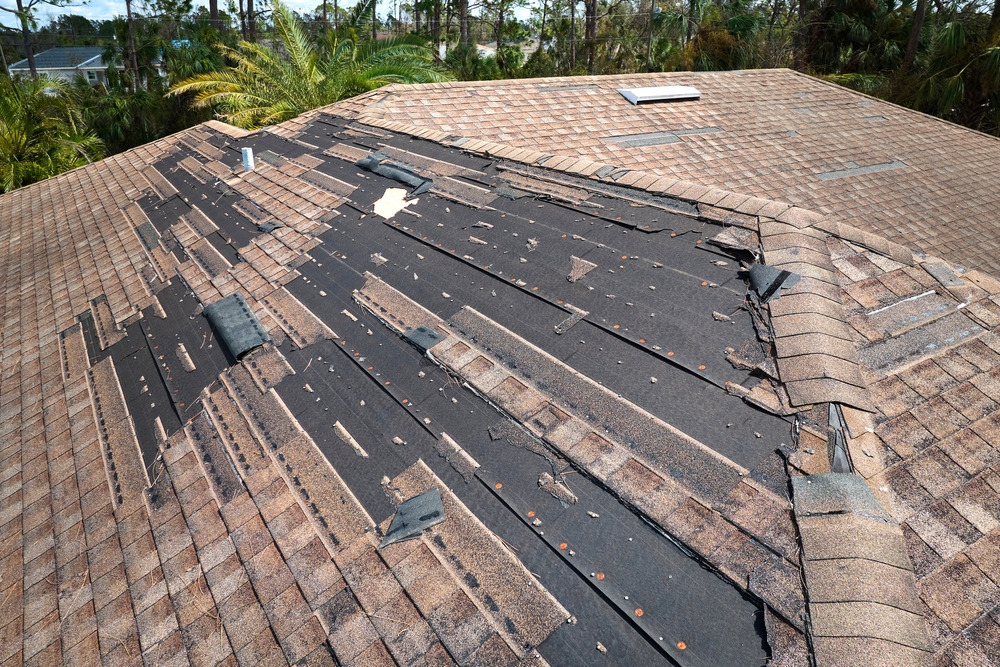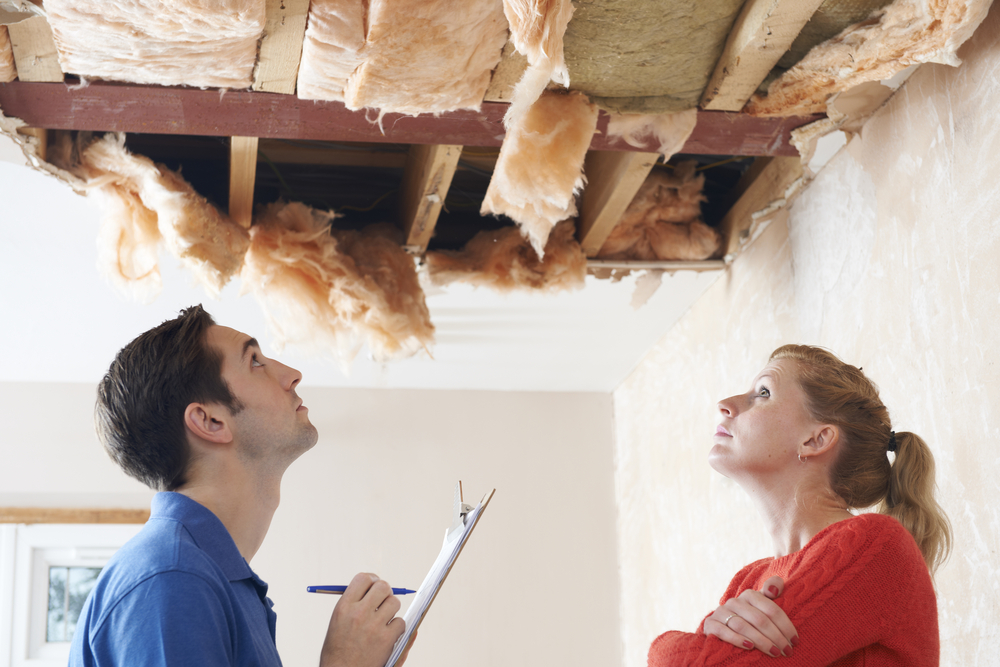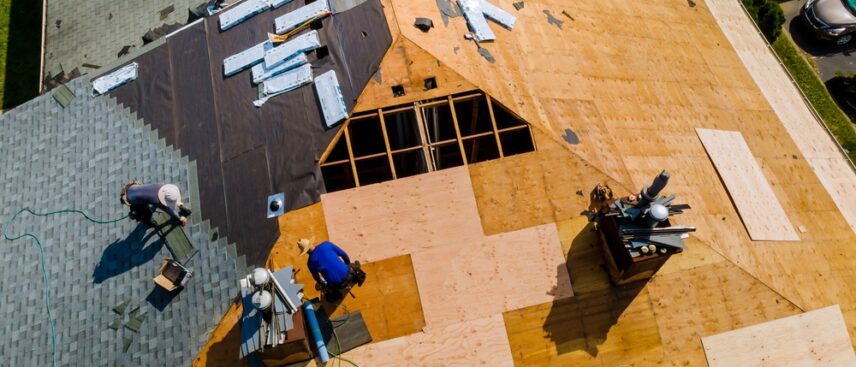Your roof protects your home’s exterior and interior walls from the elements. Keeping up with minor roof repair issues prevents them from turning into major, expensive repairs later.
Proof that you regularly maintain your roof also supports any insurance claims you may need to make at some point.
Read this blog post to learn more about signs that you need to repair your roof, common and emergency repairs, the roof repair process, how much repairs cost on average, and preventative roof maintenance that you can do to reduce the need for repairs.
Signs You Need Roof Repair

You may think of the roof’s exterior when looking for signs that you need repairs, but Bob Vila suggests you check your attic first.
Some signs you need your roof repaired include:
- Visible leaks or water stains: Look out for water stains or streaks on your attic walls and ceiling, mold, and light shining through the ceiling. Stains and streaks on the walls, floors, and ceilings of other interior rooms or bulges in interior walls may represent more serious damage from a leaking roof. Rotten wood also signals that you need to repair your roof.
- Damaged or missing shingles: Curled or cupped shingles with the edges curling up, clawed shingles with the center raised and the edges still in contact with the roof, and loose or cracked shingles provide exterior signs that you need a roof repair. Shingles may also be missing from your roof, or you may find pieces of broken shingles in your yard. Cedar shakes may show signs of damage from insects such as termites or carpenter ants.
- Damaged flashing: The flashing on your roof seals and prevents leaks at the points where chimneys and vents emerge through your roof and where the roofs of dormers or the wings of your house join the main roof. Rusted or damaged flashing needs repair.
- Granule loss: You may see spots with missing granules on asbestos shingles or find granules in your gutters or downspouts.
- Sagging roofline: Look for sags in your roofline or places where your roof dips. Also, check your roof’s fascia and soffits for cracks, rot, or warping.
Common Roof Repairs
The most common, easiest, and least expensive roof repair involves replacing missing or damaged shingles. Replacing shingles is also the least disruptive to your life.
Water stains on the exterior walls of your home may indicate that your gutters and downspouts need to be cleaned or repaired.
Roof leak repair may require replacing the flashing or shingles. A leak that has caused more extensive interior damage requires more expensive and disruptive shingle repair.
Depending on the source, repairing more serious leaks may require repairing or replacing the roof’s decking and sheathing, repairing the chimney or a skylight, replacing roof trusses, replacing the soffits and fascia, replacing drywall, replacing two-by-fours.
Emergency Roof Repair
If you need an emergency roof repair due to storm damage, a fallen tree, or another source, check your homeowners’ insurance policy to see if the damage is covered.
Also, check to see if you can make temporary repairs immediately. Some policies require waiting until your insurance adjuster has examined your roof.
You should document the damage and call your insurance company to report the damage as soon as possible. Your insurance company may limit the time you have to report damage. If you miss that reporting period, your insurer may attribute some of the damage to wear and tear and depreciate your payment.
Documented regular roof inspections and maintenance help to prove that your roof was in good condition before the damage occurred. With this proof, you stand a better chance of receiving payment for the full cost of your repair.
Make temporary repairs as soon as possible to prevent further damage and ensure your insurer does not depreciate your claim.
The Roof Repair Process
Identify the Source of the Problem

If a tree or tree branch has fallen through your roof, the source of your damage is obvious, but sources of leaks may be harder to locate. Today’s Homeowner recommends starting with the most likely sources and then checking less likely ones.
The search for sources starts with your shingles, flashing, gutters, and roof edges. The next step is to look for leaks or signs of water damage inside your home. In addition to water stains on walls, ceilings, and floors, look for dampness, sags, pooled water, and drips.
Sagging ceilings or bulged walls indicate serious problems that may need drywall and framing two-by-fours replaced.
It’s easiest to find drips when it is raining, but some drips may not appear unless you have had heavy rains. In addition, water can leak into your roof in one area and then flow down your roof’s decking or rafters to form a drip in a different area.
Repair the Damage
If missing, damaged, or loose shingles or tiles allow the leak, the next step is to reattach the loose shingles or tiles and replace the missing and damaged ones. When repairing your roof, match the replacement shingles or tiles to the ones you already have as closely as possible.
If rusted or damaged flashing contributes to your leak, replace it after preparing or replacing the shingles or tiles.
Filling holes, cracks, or gaps between flashing and chimneys, vents, skylights, or other protrusions through your roof with sealant and a caulking gun completes the final step to minor roof repairs.
Ensure Proper Ventilation and Flashing
Ensuring that your roof has proper ventilation can prevent warped shingles, mold, dampness, heat blistering in the summer, and ice dams in the winter. Your ventilation system should allow 1 square foot of open area that allows air to pass through for every 150 square foot section of your attic.
Cost of Roof Repair
The cost of a roof repair depends on the extent of the damage, the age of the roof, its size and steepness, and its roofing materials.
Forbes lists the average range of repair costs in 2024 as between $150 and $8,000, with an overall average of $1,150. Architectural Digest states that roof repairs will average between $400 and $2,000 in 2024, with an average cost of $1,200.
Architectural Digest also breaks down common repair costs for 2024.
| Type of Roof Repair | Average Range of Costs (2024) |
| Flashing | $150-$1,000 |
| Shingle replacement | $200-$700 |
| Tile replacement | $250-$$2,500 |
| Leaks | $400-$2,500 |
| Roof trusses | $500-$5,000 |
| Fascia/soffits | $600-$6,000 |
| Sagging | $750-$4,000 |
| Rot | $800-$5,000 |
| Water damage | $800-$7,000 |
If you are turning in a claim for roof repairs, your insurance company may require you to get an estimate of the cost.
When requesting an estimate, you should ask for it in writing. Your estimate should describe the damage in detail as the roofer sees it. It should also include a detailed description of the repairs, the materials and services the roofer will use to complete them, and the associated costs.

If your insurance claim is denied, your estimate shows how much you will need to pay for the repairs.
You may want to get three estimates, but if you show multiple estimates to your adjuster. Your insurer may use the lowest estimate as the basis for your payment.
However, if you have multiple estimates from qualified roofers, you can review their services and the costs. That information gives you a better idea of which company is the best roofer for your situation and budget.
Preventative Roof Maintenance
Having a roof inspection scheduled at least once a year provides documented evidence that you engage in regular roof maintenance. As mentioned, regular inspections locate minor damage that can be repaired with less expense and interruptions to your life.
Fall inspections uncover damage you want to repair before winter. Spring inspections reveal damage resulting from winter weather. Twice annual inspections prepare your roof for winter and find winter’s damage before potential spring storms make it worse.
Roof inspections and proof of the recommended repairs provide a record of your roof’s age and condition should you need to make an insurance claim or decide to sell your home. Presenting information about roof maintenance to potential home buyers may give you an advantage over other sellers and result in a higher price and faster sale.
Preventative roof maintenance can also reduce the chances that you need repairs. The following steps maintain your roof in good condition:
- Have trees near your home inspected for disease
- Remove diseased trees and branches if they might fall on your house
- Remove damaged branches
- Prune branches that overhang and come in contact with your roof
- Clean your gutters and downspouts in the spring and fall
- Clean your roof once a year to remove moss and fungi
- Seal cedar shake shingles
Together, preventative roof maintenance and regular roof inspections extend the life of your roof, reduce the need for repairs, and save you money by revealing minor damage before it becomes major damage.
